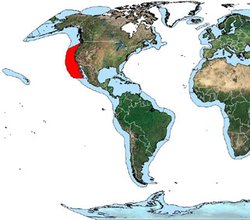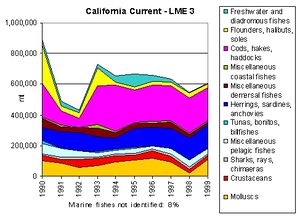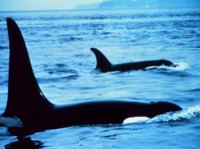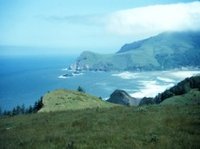California Current large marine ecosystem

The California Current large marine ecosystem is a large marine ecosystem (LME) characterized by its temperate climate. It is a transition ecosystem between subtropical and subarctic water masses with a coastal upwelling along the west coast of North America. The California Current Large Marine Ecosystem is separated from the Gulf of Alaska LME by the Subarctic Current, which flows eastward from the western Rim of the Pacific Ocean. The California Current system is extremely complex. Natural environmental change is the primary force driving the LME, with intensive fishing as the secondary driving force. Important hypotheses concerned with the growing impacts of water pollution (Pollution), resource exploitation, and environmental changes on sustained biomass yields are under investigation. LME book chapters and articles pertaining to the California Current Large Marine Ecosystem include MacCall, 1986, Mullin, 1991, Bakun, 1993, Bottom et al. 1993, McGowan et al., 1999, Brodeur et al., 1999 and Lluch-Belda et al., 2003.
Contents
Productivity
The upwelling coastal phenomenon, El Niño, and the El Niño Southern Oscillation (ENSO) result in strong interannual oscillations in the productivity of the ecosystem and, consequently, of the catch levels of different species groups (see Bakun 1993, and FAO (Food and Agriculture Organization (FAO)), 2003). ENSO events are characterized locally by an increase in temperature, a rise in coastalsea level, diminished upwelling, and increased coastal rainfall (see Bakun, 1993). The California Current large marine ecosystem is considered a Class II, moderately high (150-300 gC/m2-yr) productivity ecosystem based on SeaWiFS global primary productivity estimates. There is evidence of a decline in zooplankton abundance in recent decades, which might be an indication of a major regime shift (see California Cooperative Oceanic Fisheries Investigations (CalCOFI) a program that has sampled zooplankton biomass almost continuously from 1956 to 1980). Miller (1996) reports a significant deepening of the thermocline off California, which he attributes to a deepening and weakening of the Aleutian Low (decadal scale), and to waves propagating through the ocean from the tropics (interannual scale). There is speculation as to what causes changes in the eastern bifurcation of the Subarctic Current into the California Current, and the possible effects of these changes on biological production in this LME. These biomass changes appear to be inversely related to those occurring in the Gulf of Alaska LME to the North (see Brodeur et al., 1999). For a study of interannual variability impacts on the LME, see Lluch-Belda et al., 2003.
There is a need for a better understanding of the role of climate and seasonal change in the regulation of populations and communities of the California Current system, and of the feedback loops that determine community structure, regulate energy flow and population dynamics. For a study of the differences in chlorophyll and sea surface temperature during the El Niño/La Niña period of 1998/1999, see Kahru and Mitchell, GRL, vol. 27 no. 18, Sep 15, 2000. Also review the initiative by Miller et al on "Observing and Modeling the California Current System". Information on the U.S. GLOBEC Northeast Pacific Program is available as well as a CalCOFI Zooplankton database .
Fish and fisheries

There is a positive correlation between indices of upwelling intensity and recruitment success for commercially important fish stocks. However, dispersal by the seaward Ekman transport appears to limit fish spawning in the area, with fish migrating large distances to the Southern California Bight between upwellings to spawn (Bakun, 1993).The boundaries of NOAA’s Pacific Coast region correspond to those of the California Current LME, except that the LME extends to Baja California, Mexico. Natural environmental change is the primary force driving the LME, with intensive fishing as the secondary driving force. These forces are believed to be resulting in long-term shifts in abundance levels of both sardines and anchovies in this LME. The CalCOFI program (California Cooperative Oceanic Fisheries Investigations) was originally set up to examine the reasons for a decline of the Pacific sardine, and to study its physical and biotic habitat (see CalCOFI Committee, 1990).
The collapse of the Pacific sardine exemplifies how an ecological hange can have cascading effects on other ecosystem components including marine birds. For a time series of sardine and anchovy spawning biomass from 1930 to 1985, see MacCall, 1986. The major commercial fish species are Pacific salmon, pelagic fishes (Pacific sardine, northern anchovy, jack mackerel, chub (Pacific) mackerel, Pacific herring), groundfish, and Pacific halibut (see Our Living Oceans, 1999). Shrimp, crab, clam and abalone have high commercial value (see Our Living Oceans, 1999).Total catch has fluctuated from 900,000 metric tons in 1990 to 600,000 metric tons in 1999, with a crash down to 450,000 tons in 1992 (see FAO, 2003, graph p. 64). A recent compilation of species residing in the nearshore California Current LME can be reviewed at the California Fish and Game site . For detailed fish catch statistics for this LME, see data collected by the University of British Columbia Fisheries Center . The Food and Agriculture Organization (FAO) also has catch statistics for the last decade. The catch composition is diverse, with cods, hakes and haddocks contributing more than 30% of the catch (see FAO, 2003 as well as the figure below). Flounders, halibuts and soles, cods, hakes and haddocks crashed in 1991 and 1992. The cod collapse was followed by an increase in gadiform catches (mainly of Merluccius products), which have since remained high. Most fish stocks, including all five salmon species (chinook, coho, sockeye, pink and chum), are fully utilized or overutilized. For statistics on landings of coho, chinook (both commercial and recreational), sockeye, chum, and pink salmon between 1960 and 1997 in this LME, see Our Living Oceans, 1999. The long term potential yield, a term analogous to the concept of Maximum Sustainable Yield (MSY) in fisheries science, is set at 852,263 tons for this LME (see Our Living Oceans, 1999).
Fisheries management, especially for salmon, is complex (there are conflicting jurisdictions, and the salmon originate from several rivers). A comprehensive plan for the management of marine resources in this LME was developed (see Bottom et al., 1989, and Our Living Oceans, 1999). Efforts are underway to implement ecosystem management in this LME. The various management methods presently used are described on page 176 of Our Living Oceans. There is a need to know more about competitive and predatory interactions, and about climate effects on the fish community.
Pollution and ecosystem health

The decline of species abundance coincides with a change in oceanographic regime. The major environmental threats to this LME are the intensive harvesting of commercial fish, releases of captive-bred salmon, low-level and chronicpollution from multiple sources (see Bottom et al., 1993). Habitat degradation, dam construction, logging, agriculture, increased urbanization, increased coastal populations, grazing and pollution (Water pollution) are factors affecting the freshwater needed for spawning and juvenile rearing. For this LME as a whole, water clarity and dissolved oxygen are good, benthos and fish tissue condition are fair, and coastal wetlands, eutrophic condition and sediment are considered poor (EPA’s 7 primary indicators for this LME in EPA, 2001). The main problem is sediment contamination. The potential for benthic community degradation and fish contamination is increasing (EPA, 2001).
A decline in seabirds such as the sooty shearwater has been observed. The LME contains large populations of seabirds and marine mammals (Bakun, 1993) that include sea lions and Northern elephant seals. Pinnipeds are increasing rapidly and they are consuming large quantities of fish (DeMaster, 1983). For more information on marine mammals as indicators of LME health, see Our Living Oceans, 1999, p. 238.
There is a lack of consistent monitoring for health and water pollution in this LME.
An important element of ecosystem research within the LME is that conducted by the Marine Mammal Center, Marin County, California; thier ongoing work links the health of marine mammals with water quality, food chain and marine pathogens.
Socioeconomic conditions
The LME borders northern California, Oregon, Washington and Baja California, Mexico. Three major estuaries, the San Francisco Bay, the Columbia River and Puget Sound, contribute to the local economies of the area and enhance the quality of life for those who live here. Puget Sound provides valuable habitat for fish and wildlife, and supports one of the leading trade centers on the West Coast. There are increasing human population pressures in Puget Sound, the Seattle-Tacoma region, San Francisco Bay, and southern California. The population increased 45% between 1970 and 1980, according to the U.S. Bureau of the Census, 1996. An increase in the demand for oil, gas, and mineral resources (e.g., chromite-bearing black sands and titanium sands off the Oregon and Washington coasts, sand and gravel dredging) has stimulated an exploration of the non-living resources of the Exclusive Economic zone. The Pacific Northwest Coastal Ecosystems Regional Study (PNCERS) explores how coastal [[ecosystem]s] can respond to the natural variability of the ocean and atmosphere and to the effects of human activities.
Governance

The LME is bordered by Mexico and the USA. Some critical issues requiring management include wild salmon stocks, and significant loss of wild salmon spawning and rearing habitat (see EPA, 2001, p. 153). The Pacific Fishery Management Council (PFMC) manages fisheries (Fisheries and aquaculture) in this LME. US States and tribal fishery agencies cooperate with the PFMC. For instance, a Northwest Indian Fisheries Commission (NWIFC) is located in Washington State. However, the 3 US States bordering this LME have differing agendas. The PFMC has developed fishery management plans for salmon, groundfish and coastal pelagic species (see also “Fish and Fisheries”). It recommends Pacific halibut harvest regulations to the International Pacific Halibut Commission. See The Oregon Ocean Resources Management Plan (Oregon Ocean Resources Management Task Force, 1988), which develops general policies for the use of living and non-living resources in federal and state waters of the Oregon continental margin. For information on the management of California's Ocean Resources, see the Executive Summary . In California, some species are managed by the Pacific Fishery Management Council, while others are managed by state agencies such as the California legislature and the California Fish and Game Commission . The Mexican portion of the LME has minimal fisheries regulation, with only some fauna and marine mammal protection. There is a Puget Sound Ambient Monitoring Program (PSAMP). For information concerning the San Francisco Bay Estuary Project, see http://www.abag.ca.gov/bayarea/sfep.
Further reading
- Bakun, Andrew. 1993. "The California Current, Benguela Current, and Southwestern Atlantic Shelf Ecosystems: A Comparative Approach to Identifying Factors Regulating Biomass Yields." in Kenneth Sherman, Lewis M. Alexander, and Barry D. Gold (eds), 1993. Large Marine Ecosystems, Stress, Mitigation and Sustainability. (Washington, D.C.: American Association for the Advancement of Science) pp.199-221. ISBN: 087168506X.
- Bottom, Daniel L., Jones, Kim K., Rodgers, Jeffrey D., and Brown, Robin F. 1993. Research and Management in the Northern California Current Ecosystem. in Kenneth Sherman, Lewis M. Alexander, and Barry D. Gold (eds), 1993. Large Marine Ecosystems, Stress, Mitigation and Sustainability. American Association for the Advancement of Science. Washington, D.C. pp. 259-271. ISBN: 087168506X.
- Bakun, A. and Nelson, C.S. 1977. Climatology of upwelling-related processes off Baja California. CalCOFI Rep. 19:107-127.
- Bedford, D., Jow, T., Klingbeil, R., Read, R., Spratt, J., and Warner, R. 1983. Review of some California fisheries. Calif. Coop. Ocean. Fish. Invest. Rep. 24:6-10.
- Bottom D.L. and Jones, K.K. 1990. Species composition, distribution, and inverterbrate prey of fish assemblages in the Columbia River estuary. Prog. Oceanogr. 25:243-270.
- Bottom, D.L. et al. 1989. Management of living marine resources, a research plan for the Washington and Oregon continental margin. Publication No. NCRI-T-89-004. National Coastal Resources Research and Development Institute, Newport, OR.
- Bottom, D.L., et al. 1986. Research and development of Oregon’s coastal salmon stocks. Oregon Department of Fish and Wildlife Progress Reports (Fish), Project No. AFC-127, 30 September 1985 to 29 September 1986, Portland, OR.
- Brodeur R.D., and D.M. Ware, 1995. interdecadal variability in distribution and catch rates of epipelagic nekton in the Northeast Pacific Ocean. In Climate change and northern fish populations. R. Beamish, ed. Can. Spec. Pub. Fish. Aquat. Sci. 121-329-356. ISBN: 0660157802.
- Brodeur, R.D., Frost, B.W., Hare, S.R., Francis, R.C., and W.J. Ingraham, Jr., 1999. "Interannual variations in Zooplankton Biomass in the Gulf of Alaska, and Covariation with California Current Zooplankton Biomass". in Kenneth Sherman and Qisheng Tang (eds), Large Marine Ecosystems of the Pacific Rim—Assessment, Sustainability, and Management. (Blackwell Science) pp. 106-138.
- CalCOFI Committee. 1990. Fortieth Anniversary Symposium of the CalCOFI Conference. CalCOFI Rep. 31:25-59.
- California Dept. of Fish and Game. 1990. Review of some California fisheries for 1989. CalCOFI Rep. 31:9-21.
- DeMaster, D. 1983. Annual consumption of northern elephant seals and California sea lions in the California Current (abstract). Calif. Coop. Ocean. Fish. Invest. Annual Conference 1983, Program and Abstracts.
- EPA, 2001. National Coastal Condition Report.
- FAO, 2003. Trends in oceanic captures and clustering of large marine ecosystems—2 studies based on the FAO capture database. FAO fisheries technical paper 435. 71 pages.
- Hammann, M.G., Baumgartner, T.R., and Badan-Dangon, A. 1988. Coupling of the Pacific sardine (Sardinops sagax caeruleus) life cycle with the Gulf of California pelagic environment. CalCOFI Rep. 24:102-109.
- Husby, D.M., and Nelson, C.S. 1982. Turbulence and vertical stability in the California Current. CalCOFI Rep. 23:113-129.
- Klingbeil, R. 1983. Pacific mackerel: A resurgent resource and fishery of the California Current. Calif. Coop. Ocean. Fish. Invest. Rep. 24:35-45.
- Kenya, V.S. 1982. New data on the migrations and distribution of Pacific sardines in the Northwest Pacific. Sov. J. Mar. Biol. 8(1):41-48.
- Lasker, R. 1978. The relation between oceanographic conditions and larval anchovy food in the California Current: Identification of the factors leading to recruitment failure. Rapp. P.-v. Reun. Cons. Int. Explor. Mer 173:212-230.
- Laurs, R. 1983. The North Pacific albacore - An important visitor to California Current waters. Calif. Coop. Ocean. Fish. Invest. Rep. 24:99-106.
- Lee, K.N. 1989. The Columbia River Basin: Experimenting with sustainability. Environment. 31:6-33.
- Lluch Belda, D., DB Lluch Cota and S. Lluch Cota, 2003. Interannual variability impacts on the California Current Large Marine Ecosystem (volume in press).
- MacCall, A. 1983. Variability of pelagic fish stocks off California in Proceedings of the expert consultation to examine changes in abundance and species composition of neritic fish resources. San Jose, Costa Rica, 18-29 April 1983. pp. 101-112. ed. by G. Sharp and J. Scirke. FAO Fish. Rep. 291(2):1-553.
- MacCall, A., Methot, R., Huppert, D., and Klingbeil, R. 1983. Northern anchovy fishery management plan. October 24, 1983. Pacif. Fish. Management Council, 526 SW Mill Street, Portland, OR 97201.
- MacCall, Alec D. 1986. "Changes in the Biomass of the California Current Ecosystem." in Kenneth Sherman and Lewis M. Alexander (eds.), Variability and Management of Large Marine Ecosystems (Boulder: Westview-AAAS Selected Symposium 99) pp. 33-54.
- McGowan, J.A., Chelton, D.B. and A. Conversi, 1999. Plankton patterns, climate, and change in the California Current. in Kenneth Sherman and Qisheng Tang (eds), Large Marine Ecosystems of the Pacific Rim—Assessment, Sustainability, and Management. (Blackwell Science) pp. 63-105.
- Miller, A.J., 1996. Recent advances in California Current modeling: decadal and interannual thermocline variations. Calif. Coop. Oceanic Fish. Invest. Rep. 37.
- Morgan, J., 1989. Large Marine Ecosytems in the Pacific Ocean. in Kenneth Sherman, and Lewis M. Alexander (eds), Biomass Yields and Geography of Large Marine Ecosystems. Westview Press. 377-394.
- Mullin, M. M. 1991. Spatial-Temporal Scales and Secondary Production Estimates in the California Current Ecosystem. in Kenneth Sherman, Lewis M. Alexander, and Barry D. Gold (eds), Food Chains, Yields, Models, and Management of Large Marine Ecosystems. Westview Press) pp. 165-192.
- Our living oceans—report on the status of U.S. Living Marine Resources, 1999. NOAA. 301 pages
- NRC (National Research Council). 1985. ISBN: 0309034795 Oil in the sea: Inputs, fates, and effects. National Academy Press, Washington, D.C.
- Oregon Ocean Resources Management Task Force. 1988. Managing Oregon’s ocean resources. Interim report to the Joint Legislative Committee on Land Use, July 1, 1988. Oregon Department of Land Conservation and Development, Portland, OR.
- Parrish, R.H., Nelson, C.S., and Bakun, A. 1981. Transport mechanisms and reproductive success of fishes in the California Current. Biol. Oceanogr. 1:175-203.
- Parrish, R.H., Bakun, A. Husby, D.M., and Nelson, C.S. 1983. Comparative climatology of selected environmental processes in relation to eastern boundary current pelagic fish reproduction. in Proceedings of the expert consultation to examine changes in abundance and species composition of neritic fish resources. pp. 731-778. ed. by G.D. Sharp and J. Csirke. FAO Fish Rep. 291. FAO
- Peterman, R.M. 1990a. Statistical power analysis can improve fisheries research and management. Can. J. Fish. Aquat. Sci. 47:2-15.
- Peterman, R.M. 1990b. The importance of reporting statistical power: The forest decline and acidic deposition example. Ecology 71:2024-1017.
- Prager, M.H., and MacCall, A.D. 1990. Biostatistical models of contaminant and climate influences on fish populations of the Southern California Bight. Old Dominion University Oceanography Tech. Rep. 90-04.
- Roemmich, D., and J. McGowan, 1995a. Climatic warming and the decline of zooplankton in the California Current. Science 267:1324-1326.
- Roemmich, D., and J. McGowan, 1995b. Sampling zooplankton: correction. Science 268:352-353.
- Saiki, M. 1988. Time dependent variability with a few decades. in: Studies on fishery oceanography—Proceedings of the 25th anniversary symposium "Fisheries and fishery oceanography in the coming century," Tokyo, November 10-13, 1986. pp. 358-366. Japanese Society of Fisheries Oceanography.
- Smith, R.L. 1974. A description of current, wind, and sea level variations during coastal upwelling off the Oregon Coast, July-August 1972. J. Geophys. Res. 79:435-443.
- Starr R.M. and Saelens, M.R. 1987. Identification of important marine habitat. Oregon Department of Fish and Wildlife, Project Completion Report. Portland, OR.
- Ware, D.M., and Thomson, R.E. 1991. Link between long-term variability in upwelling and fish production in the northeast Pacific Ocean. Can. J. Fish. Aquat. Sci. 48:2296-2306.
- Wooster, W.S., and Reid, J.L., 1963. Eastern boundary currents. In: The sea. Vol. 2. pp. 253-280. Ed. by M.N. Hill. Interscience Pub., New York.
- Wyllie, J.G. 1966. Geostrophic flow of the California Current at the surface and at 200 m. CalCOFI Atlas No. 4. Scripps Institution of Oceanography, La Jolla, CA.
| Disclaimer: This article contains some information that was originally published by the National Oceanic and Atmospheric Administration (NOAA). Topic editors and authors for the Encyclopedia of Earth have edited its content and added new information. The use of information from the National Oceanic and Atmospheric Administration (NOAA) should not be construed as support for or endorsement by that organization for any new information added by EoE personnel, or for any editing of the original content. |